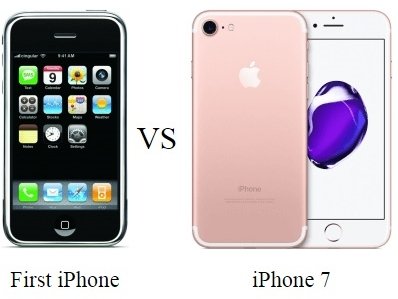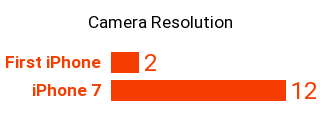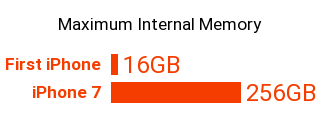
Back in 2007, when the term smartphone was still jargon, the iPhone was a response to Motorola's once-wildly-popular RAZR flip phone and Nokia's N95 slider (both of which are now considered legacy phones), dabbling with the idea of a touchscreen-only handset that could compare with the famous phones of its era. Nine years later and numerous iPhones in, our specs comparison between the First iPhone versus the 2016 iPhone 7 reveals how much has changed from the Original iPhone's exploratory offering up to the iPhone 7's flagship-class feature set. Hills may be steep. Please remain seated.
| Camera Details | |||||||||||||||||||
|---|---|---|---|---|---|---|---|---|---|---|---|---|---|---|---|---|---|---|---|
 Fast-forward to 2016, the iPhone 7 now boasts a 12-megapixel camera, which not only posts a 600% increase in camera resolution over the First iPhone, but also captures Ultra HD (3840 x 2160) videos, touts a 6-element sapphire-covered lens, and has a quad-LED true-tone flash -- the first of its kind. Accompanying it is a 7-megapixel FaceTime HD front-facing camera. For a much clearer view of this camera comparison between the Original iPhone and the iPhone 7, our colleagues over at the Verge compared actual shots of both iPhones in a head-to-head camera showdown. While both of the iPhone 7's cameras dwarf that of the Original iPhone's (as revealed by the significant differences), however, it's not exactly the be-all-end-all of camera phones, since we have seen up-to-23-megapixel rear cams and a few 16-megapixel selfie shooters, though it is safe to say that imaging is a key factor in the iPhone's progress. Here are more Camera Details details to compare: | |||||||||||||||||||
| Camera Resolution | 2-megapixel | 12-megapixel | |||||||||||||||||
| Camera flash | ? | Quad-LED True Tone | |||||||||||||||||
| Camera Optics | ? | 6-element lens with sapphire crystal cover | |||||||||||||||||
| Camera Aperture | ? | f/1.8 | |||||||||||||||||
| Digital Zoom | ? | 5x | |||||||||||||||||
| Max Video Resolution | ? | 3840 x 2160 px | |||||||||||||||||
| Video frames per second | ? | 30 | |||||||||||||||||
| SELFIE CAMERA Comparison Of The First iPhone Vs iPhone 7 | |||||||||||||||||||
| Apple iPhone | iPhone 7 | ||||||||||||||||||
| Selfie Cam Resolution | ? | 7-megapixel FaceTime HD | |||||||||||||||||
| Selfie Options | ? | 1080p (Full HD) video recording | |||||||||||||||||
| Selfie Features | ? | Auto HDR | |||||||||||||||||
| Selfie flash | ? | Retina Flash | |||||||||||||||||
| Aperture | ? | f/2.2 | |||||||||||||||||
| Display | |||||||||||||||||||
.png) Apple also built around the growth of the iPhone screen with several desirable display perks, including the 3D Touch pressure-sensing technology, a fingerprint-resistant oleophobic coating, and a 625nit maximum brightness level. All that said, despite the huge differences between the first and the latest (as of 2016) model, the iPhone has a pretty huge mountain to climb if it wants to sit at the top of the display food chain, since most of the models in our list of the top smartphones in the US as of 2016 boast Quad HD (2560 x 1440) screens with roughly 500ppi densities. As far as this display comparison is concerned, however, the iPhone 7 possibly makes its 2007 ancestor proud. Here are more comparison points: | |||||||||||||||||||
| Apple iPhone | iPhone 7 | ||||||||||||||||||
| Display size | 3.5 in | 4.7 in | |||||||||||||||||
| Display dots per inch | 165 DPI | 326 DPI | |||||||||||||||||
| Display Type | TFT | LED-backlit IPS Retina HD | |||||||||||||||||
| Display Resolution | 480 x 320 px | 1334 x 750 px | |||||||||||||||||
| Display's superficy | 5.65 sqr in | 9.43 sqr in | |||||||||||||||||
| Display finish | ? | Fingerprint-resistant oleophobic coating | |||||||||||||||||
| Display brightness | ? | 625 nits | |||||||||||||||||
| Display contrast | ? | 1400:1 nits | |||||||||||||||||
| Performance | |||||||||||||||||||
 As for storage, the First iPhone's 16GB non-expandable maximum inbuilt memory (the earliest editions only had 8GB or 4GB memories) has since fallen into the entry-level realm. Now, the iPhone 7 struts around with a larger memory than all previous iPhone models', at 256GB (128GB and 32GB versions are also offered), which only a handful of Android-based phones featured as of its release. A 1600% percent increase over the Original iPhone's memory from a little under a decade ago? We'll take it. While some of our tech-savvy friends still take issue with the iPhone's lack of a memory card slot, and though the iPhone 7 is not exactly the fastest smartphone out there, if there's one thing we can learn from this hardware comparison between the 2016 iPhone edition and its great grandfather, its that the iPhone has come a long way in terms of performance. Here are more specs to check out: | |||||||||||||||||||
| Apple iPhone | iPhone 7 | ||||||||||||||||||
| Operating System | iOS 3.1.3 | iOS 10 | |||||||||||||||||
| Processor | ? | A10 Fusion with embedded M10 motion coprocessor | |||||||||||||||||
| CPU Cores | 1 | 4 | |||||||||||||||||
| CPU architecture | ? | 64-bit | |||||||||||||||||
| CPU clock speed | 412MHz | ? | |||||||||||||||||
| Physical Features | |||||||||||||||||||
.png) The most-obvious disparities are the iPhone 7's 67.1mm width and 138.3mm height, compared to the iPhone 1's 61mm and 115mm respectively, but these are only consequences of enlarging the display. What really got our attention is the iPhone 7's much-thinner body of only 7.1mm -- about 163% sleeker than the First iPhone's 11.6mm shell. As a result, the iPhone 7 likely joins the phones in our latest list of the thinnest smartphones. Note, though, that the iPhone 7 scratched the standard 3.5mm headset jack, probably to retain its slim form factor, but that's a conversation for a another day. Another of the iPhone 7's tricks-up-its-sleeves is its IP67-grade waterproofing, which, though nothing new among Android devices, is a first for the iPhone. This makes the iPhone 7 more-fit for pool parties than all of its predecessors. Here are more Physical Features features to look at: | |||||||||||||||||||
| Apple iPhone | iPhone 7 | ||||||||||||||||||
| Weight | 4.8 oz | 4.87 oz | |||||||||||||||||
| Weight grams | 135 | 138 | |||||||||||||||||
| Thickness | 0.46 in | 0.28 in | |||||||||||||||||
| Width | 2.4 in | 2.64 in | |||||||||||||||||
| Height | 4.5 in | 5.44 in | |||||||||||||||||
| Thickness (metric) | 11.6 mm | 7.1 mm | |||||||||||||||||
| Width (metric) | 61 mm | 67.1 mm | |||||||||||||||||
| Height (metric) | 115 mm | 138.3 mm | |||||||||||||||||
| Ounces per cubic inch | 0.97 | 1.21 | |||||||||||||||||
| Grams per cubic cm | 0.17 | 0.21 | |||||||||||||||||
| Rugged | ? | IP67 (IEC standard 60529) | |||||||||||||||||
| Ambient light detector | ? |  | |||||||||||||||||
| Connectivity | |||||||||||||||||||
| Apple iPhone | iPhone 7 | ||||||||||||||||||
| 3G networks | ? | TD-SCDMA, UMTS/HSPA+/DC-HSDPA | |||||||||||||||||
| 4G networks | ? | TD-LTE, FDD-LTE | |||||||||||||||||
| Maximum data rate | ? | 450Mbps | |||||||||||||||||
| SIM card type | Mini SIM (2FF) | Nano SIM | |||||||||||||||||
| Wi-Fi | 802.11 b/g | 802.11a/b/g/n/ac with MIMO | |||||||||||||||||
| Head SAR value (radiation) | 0.974 w/Kg | ? | |||||||||||||||||
| Bluetooth Technology | 2.0 | 4.2 | |||||||||||||||||
| Storage Memory | |||||||||||||||||||
| Storage Memory | 16GB (8GB and 4GB versions also available) | 256GB (128GB and 32GB versions also available) | |||||||||||||||||
| Battery Life | |||||||||||||||||||
| Apple iPhone | iPhone 7 | ||||||||||||||||||
| Stand-by Time | 250 | 240 | |||||||||||||||||
| Talk Time | 480 | ? | |||||||||||||||||
| 3G Talk Time | ? | 840 | |||||||||||||||||
| Battery type | ? | Lithium-Ion (built-in) | |||||||||||||||||
| Battery Power | ? | 1960 mAh | |||||||||||||||||
| mAh per ounce | ? | 402 | |||||||||||||||||
| mAh per gram | ? | 14 | |||||||||||||||||
| mAh per mm thick | ? | 276 | |||||||||||||||||
| mAh per display square in. | ? | 208 | |||||||||||||||||
| Music Playback Time | ? | 2400 | |||||||||||||||||
| Browsing Time | ? | 720 (3G), 720 (LTE) | |||||||||||||||||
| Wi-Fi browsing time | ? | 840 | |||||||||||||||||
| Video Playback Time | ? | 780 (wireless) | |||||||||||||||||
| Other | |||||||||||||||||||
| Sensors | Accelerometer, Proximity | Three-axis gyro, Barometer, Accelerometer, Proximity, Ambient light | |||||||||||||||||
| Finish | ? | Bead-blasted 7000-series aluminum | |||||||||||||||||
After having explored the vast differences between the Original iPhone and its iPhone 7 descendant via this specs comparison, we leave you with these takeaways:
- Comparison analysis by KJ David, Phone Profiler
Legend:
 Full Menu
Full Menu